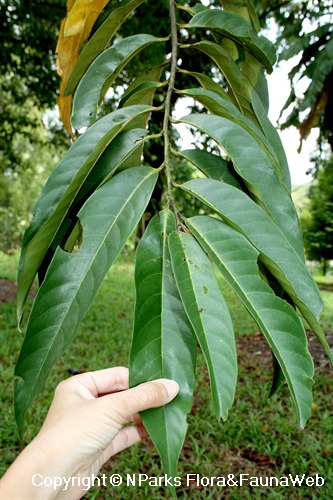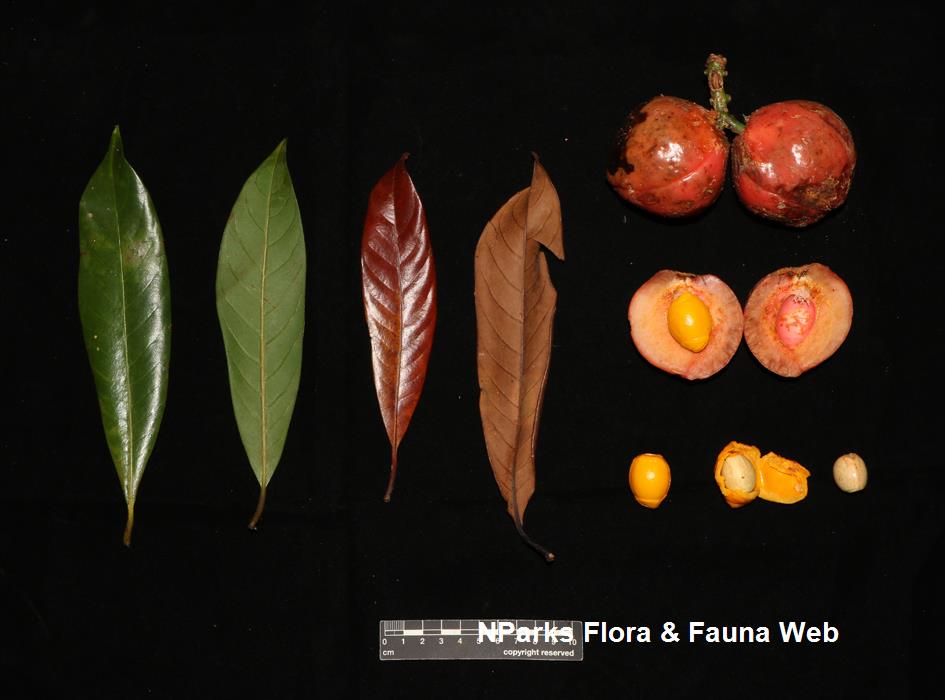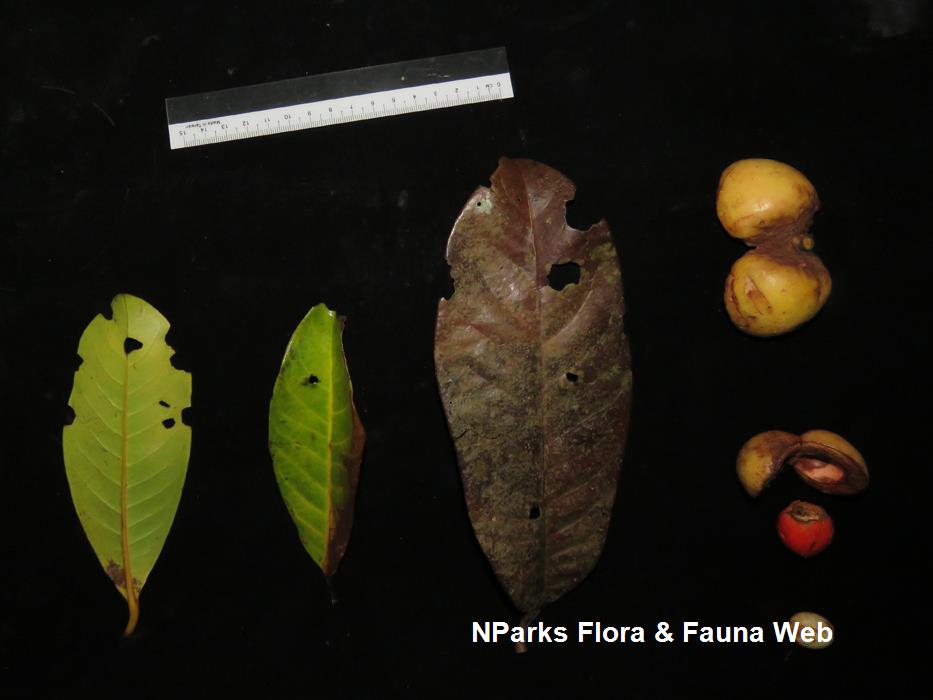
Back
Horsfieldia irya (Gaertn.) Warb.
| Family Name: | Myristicaceae |
| Synonyms: | Myristica micrantha, Horsfieldia acuminata, Myristica javanica, Horsfieldia subglobosa, Horsfieldia congestiflora, Myristica irya |
| Common Name: | Pianggu, Piasau Mamau, Salinguat, Lempoyang Paya, Penggu, Chendarah, Peredanh Burung, Kalapa Tiyung, Kalak Pucung, Darah-Darah, Kumpang |
Horsfieldia irya, also known as Pianggu, is a critically endangered tree in Singapore. It can reach up to 30 m tall and grows in swamp forests, coastal forests and riverine areas. It produces orange-red fruits which are eaten by monkeys and hornbills.
Name
Classifications and Characteristics
| Plant Division | Angiosperms (Flowering Seed Plants) (Dicotyledon) |
|---|---|
| Plant Growth Form | Tree |
| Lifespan (in Singapore) | Perennial |
| Mode of Nutrition | Autotrophic |
| Plant Shape | Columnar |
| Maximum Height | 30 m |
| Tree or Palm – Trunk Diameter | 1 |
Biogeography
| Native Distribution | Sri Lanka, Myanmar, Andaman and Nicobar Islands, Vietnam, Cambodia, Thailand, Sumatra, Peninsular Malaysia, Singapore, Borneo, Java, southern Philippines, Sulawesi, Moluccas, New Guinea, Caroline Islands, and the Solomon Islands |
|---|---|
| Native Habitat | Terrestrial (Primary Rainforest, Coastal Forest, Riverine, Secondary Rainforest, Freshwater Swamp Forest), Shoreline (Mangrove Forest) |
| Preferred Climate Zone | Tropical, Sub-Tropical / Monsoonal |
| Local Conservation Status | Native to Singapore (Critically Endangered (CR)) |
Description and Ethnobotany
| Growth Form | It is a tree that can grow up to 30 m tall, with prop-roots, and buttress roots that are 3 m tall, 2 m out, and 10 cm thick. |
|---|---|
| Trunk | Often slightly buttressed, stilt roots and pneumatophores occasionally present. Bark brown, shallowly fissured and flakey, exudates red and somewhat sticky; under-bark reddish. |
| Foliage | Its alternate, stalked leaves have membranous leaf blades that are often curved towards the tip, are elliptic-oblong to lance-shaped, 10–35 by 3–9 cm, and possess irregular white marks above. |
| Flowers | The plant is dioecious. Its flowers develop in flowering shoots (inflorescence). Its male inflorescences are 4–18 by 3–10 cm, and have flowers in clusters of 3–10. Its female inflorescences are 2–8 cm long. Its flowers are yellow, and its male flowers are smaller than its female flowers. |
| Fruit | Its fruiting bodies (infructescences) contain 2–8 fruits each. Its fruits are round, hairless, finely granular, yellowish orange, and are 1.5–3 cm across. Its round seeds are covered by an orange-red to red coverings (arils). |
| Habitat | It grows in primary and secondary forests, coastal swamps or riverine areas, up to 450 m altitude. It is known locally in Pulau Tekong. |
| Associated Fauna | Its fruits are eaten by monkeys and hornbills. |
| Cultivation | Tolerant of waterlogging and moderate salinity. Propagate by seeds and stem cuttings. |
| Etymology | Genus epithet 'Horsfieldia' named after American physician and naturalist, Thomas Horsfield (1773-1859), who travelled to Java, Indonesia in 1800, where he collected local plants and animals on behalf of his friend, Thomas Stamford Raffles, who was lieutenant-governer of Java then under the East India Company's control. Species epithet 'irya' derived from Sanskrit term meaning 'vigorous' or 'active', usage unclear. |
| Ethnobotanical Uses | Edible Plant Parts : Edible Fruits Food (Fruit or Vegetable) Medicinal: A decoction of the bark can be used as a gargle for sore throats. Latex used to clean ulcers. Leaves used to extract pus from boils and sores. Macerated root drank with lime juice as remedy for toxic snake bites. Timber & Products: Minor hardwood species. Wood used for bottle lids. Its seeds contain an oleo-resin which can be used to make varnish. Cultural / Religious: Heritage Tree : There is currently one individual of Horsfieldia irya listed as a Heritage Tree in Singapore. It can be found at the Singapore Botanic Gardens. To find out more about this tree, please visit the Heritage Tree Register. Others: Products: Essential oils from scented flowers used in perfumery. |
Landscaping Features
| Landscaping | It is suitable for planting in parks and in along streetscapes. |
|---|---|
| Desirable Plant Features | Ornamental Flowers, Ornamental Foliage, Fragrant (Flowers) (Time Independent, Day) |
| Landscape Uses | Coastal, General, Suitable for Roadsides, Riverine, Shade Providing Tree / Palm, Parks & Gardens |
| Thematic Landscaping | Golden Garden, Naturalistic Garden |
| Plant & Rootzone Preference or Tolerance Remarks | Sandy soils |
Fauna, Pollination and Dispersal
| Fauna Pollination Dispersal Associated Fauna | Bird-Attracting (Fruits) |
|---|---|
| Pollination Method(s) | Biotic (Fauna) |
| Seed or Spore Dispersal | Abiotic (Water), Biotic (Fauna) (Vertebrates (Other Mammal)) |
Plant Care and Propagation
| Light Preference | Full Sun |
|---|---|
| Water Preference | Moderate Water, Lots of Water |
| Plant Growth Rate | Moderate |
| Rootzone Tolerance | Waterlogged Soils (Drains Site), Saline Soils / Salt Spray, Well-Drained Soils, Fertile Loamy Soils |
| Maintenance Requirements | Moderate |
| Propagation Method | Seed, Stem Cutting |
Foliar
| Foliage Retention | Evergreen |
|---|---|
| Mature Foliage Colour(s) | Green |
| Mature Foliage Texture(s) | Smooth, Raised / Sunken Veins |
| Foliar Type | Simple / Unifoliate |
| Foliar Arrangement Along Stem | Alternate |
| Foliar Attachment to Stem | Petiolate |
| Foliar Shape(s) | Non-Palm Foliage (Elliptical, Lanceolate, Oblong) |
| Foliar Venation | Pinnate / Net |
| Foliar Margin | Entire |
| Foliar Apex - Tip | Acuminate |
| Foliar Base | Rounded / Obtuse |
| Typical Foliar Area | Notophyll ( 20.25cm2 - 45 cm2 ) |
| Leaf Area Index (LAI) for Green Plot Ratio | 3.0 (Tree - Intermediate Canopy) |
Non - Foliar and Storage
| Trunk Type (Non Palm) | Woody |
|---|---|
| Mature Bark Texture | Fissured, Cracked |
| Stem Type & Modification | Woody |
| Root Type | Underground (Tap Root, Fibrous Root), Aboveground (Buttress Root, Prop / Stilt Root, Pneumatophore / Pencil Root) |
Floral (Angiosperm)
| Flower & Plant Sexuality | Unisexual Flowers , Dioecious |
| Flower Colour(s) | Orange, Yellow / Golden |
|---|
| Flower Grouping | Cluster / Inflorescence |
| Flower Location | Axillary |
| Flower Symmetry | Radial |
| Flower Size - Remarks | 1.0 - 2.5mm |
| Inflorescence Type | Panicle |
| Ovary Position | Superior / Hypogynous |
| Flowering Period | Once Yearly |
| Flower Lifespan on Plant | Several Days |
| Flowering Habit | Polycarpic |
Fruit, Seed and Spore
| Mature Fruit Colour(s) | Orange, Yellow / Golden |
|---|---|
| Fruit Classification | Simple Fruit |
| Fruit Type | Fleshy Fruit , Drupe |
Image Repository
Others
| Master ID | 1671 |
|---|---|
| Species ID | 2964 |
| Flora Disclaimer | The information in this website has been compiled from reliable sources, such as reference works on medicinal plants. It is not a substitute for medical advice or treatment and NParks does not purport to provide any medical advice. Readers should always consult his/her physician before using or consuming a plant for medicinal purposes. |




















.jpg)
.jpg)
.jpg)



